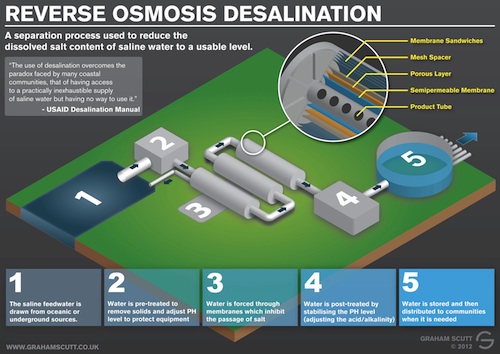California droughts right now might be the worst in 100 years, and Lake Mead’s at a fairly dangerous level (which threatens tourism mecca Las Vegas), so clearly we’re moving to the “answers” stage of our water problem. It would seem that the biggest option — at least in terms of sheer numbers — would be the oceans, since they cover well over half of Earth. Now, removing the sheer ethics of pumping the oceans dry in order to allow Vegas hotel rooms to spout water, let’s talk broadly about desalination for a second.
First off, the process involves a lot of scrutiny (as does anything related to the environment). The largest desalination plant in the Western Hemisphere, the Carlsbad Desalination Project, is currently under construction (it’s from the same Israeli company that’s helping the Alps still have snow) and should be finished by 2016. Here’s what you should know, though:
Nonetheless, it still takes about 2 gallons (8 liters) of seawater to make 1 gallon (4 liters) of freshwater, according to a 2013 report from the Pacific Institute, a nonprofit environmental and economic research group. And despite advances in energy recovery, separating salt from saltwater remains a very energy-intensive enterprise.
That’s not a great rate of return — if you grab two of something and only get the end product of one of those things, chances are you’re pretty pissed. Plus:
New plants require electricity that puts more greenhouse gases in the air, when simple conservation methods should be encouraged instead, some say. There is also the possibility that the pumps could suck in and kill small marine organisms and fish such as the endangered delta smelt, although the Concord-area plant’s designers say that’s unlikely because of its location at the side of a flowing channel.
Ah, I see … we’re back to the eternal topic of “can you save the world by being true to the world?”
But that dash of independence comes at a cost. The water authority is locked into a 30-year deal with the plant’s developer, Poseidon Water, to purchase desalted water for about $2,000 an acre foot in 2012 dollars. That’s nearly twice as expensive as the current rate for imported water and will add $5 to $7 per month to ratepayers’ bills, which is about a 10 percent hike.
So those getting the de-salted water will be paying 10 percent more on their bills, eh? Cue the politicians arguing how awful desalination is as they ramp up to another election. I’m for the middle class, and desalination is pricing out the middle class! Or you could view it this way:
“I think it will turn out that it is very affordable compared to not having the water here in Southern California, particularly with the drought that we are facing and the fact that the governor has just cut off the flow of water from north to south in the aqueduct, the State Water Project,” Randy Truby, the comptroller for the International Desalination Association, an industry advocate, told NBC News.
My biggest concern here would be — what if these 17 plants in development along the California coast (Carlsbad simply being the biggest and most expensive) start to work decently well? Are we just going to suck the oceans up to make freshwater? There’s a water cycle, sure, but what if desalination projects start cropping up everywhere? At a certain point, aren’t we taking out too much without enough returning? And, er, aren’t we ripping through energy at the same time? We’re back to three options with the oceans, then: migration, adaptation, or extinction. None is necessarily good. (No. 2 would be the most preferable.)
This has gotten to the point of semi-inevitability whereby you can analyze your best investment options in the desalination world.
Overall, this seems like a pretty prime example of “sacrificing future generations for the present ones” and maybe other ideas, like water conservation or even new ground wells, should be practiced first. If we reach the point of rampant and necessary desalination, so be it — but it certainly doesn’t seem ideal.
If you’re wondering just on base how desalination works, check this out:
There’s also this, about the adaptation of the plans in the Middle East (where it’s a bit more common because their oil-rich nature allows for the energy outputs needed):
